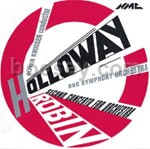3(=picc,III=afl).3(III=corA).3(I=Eb,III=bcl).asax.3(III=dbn)-4.3.3.1-
timp.perc(4):glsp/gong/t.bells/vib/xyl/9anvils/bell tree/cyms/2susp.
cyms/tam-t/3tgl/claves/maracas/ratchet/3Chin.bl/wdbl/whip/BD/SD/tamb/
TD-harp-pft(=cel)-strings
Abbreviations (PDF)
Boosey & Hawkes
The Second Concerto for Orchestra was commissioned by Glasgow’s 1979 Musica Nova Festival and first performed there that autumn. I began it at Easter 1978, completed the sketch by August, and the full score by the following spring. The background inspiration was a visit over the turn of 1977-78 to North Africa. I was excited by the extremes of contrast - opulence and austerity, richness and drabness both of colour and texture, brilliant light and dense shadow, fertility and barrenness. And above all, the noises: in the working quarters of old cities there were no distorting sounds of traffic, but only the polyphony of hammering, tapping, thudding, tinkling, bashing, on all varieties of wood, stone and metal.
The concert is in three continuous movements. Since the third is an altered reply of the first, the overall shape could be likened to a body (or a building) with a pair of matching wings. But more important than the symmetry is the sense of a journey through a shape that accumulates, making the final stage different from the first in being from the start aimed towards a definite goal.
The first movement presents a rapid succession of apparently unconnected ideas (each instrument or section has its own), bound together only by a sort of continuo on unpitched percussion. The character is fragmentry; everything leans forward and is cut short without rest or conclusion. Only towards the end is there any interaction, superimposition and sense of culmination; but before anything arrives, the forward momentum has toppled headlong into the Andante.
Here the first section sets up a background of lullaby-motion which permeates the entire movement, always altering in speed and definition. Fragments of familiar tunes drift by half-discerned, as when falling asleep. They twine in and out of the various episodes which emerge from the lullaby background and revert to it; sometimes these episodes are sharply distinguished, sometimes they are without clear beginning and end. Their main material is all derived from things that in the first movement had rushed past headlong; here they are given space to expand and develop fuller scope. In the first episode the whole orchestra takes up the percussion idea from the Allegro. The second episode is its opposite – gentle, rocking music that drifts off into the third episode, a great empty space. The fourth is the opposite again. Thickening all the way towards a saturation of material interlocked and divided against itself. Its resolution produces the movement’s, and the work’s, main climax; after which the background resumes for the last time, filling a still wider and emptier space than before. In this space comes the Concerto’s cadenza, played by three unco-ordinated streams of sounds (one led by a piccolo, one by a clarinet, and the third on the piano).
From this emerges the third movement. It begins with the ideas of the first, restored to their original shapes, seen from afar and rapidly coming to the fore as the middle movement evaporates. This finale presents the same events as the first movement in (broadly speaking) the reserve order. But now the formerly disconnected ideas are gradually shown to fit into each other. What had been a scattering of little fragments is now one big unity. As it advances, the finale incorporates material from the middle movement as well, and the snatches of tune that have been relatively furtive so far become increasingly continuous and prominent. Everything hitherto separate is connected up, every incomplete thing completed, every identity kept reserved is now let out of the bag, and every relationship implicit until now is hammered home.
The Second Concerto for Orchestra is dedicated to Oliver Knussen with affection and admiration.
Robin Holloway
Reproduction Rights
This programme note can be reproduced free of charge in concert programmes with a credit to the composer
The second of Holloway’s concertos for orchestra was commissioned by the Scottish National Orchestra and the University of Glasgow for a Musica Nova concert and is dedicated to Oliver Knussen, long a champion of Holloway’s music. The composer has written that the music was inspired by a visit to North Africa where he was struck by the contrasts of colour and light and by the polyphony of sounds heard in the working quarters of the old cities. Although the work is continuous, there are three definable sections: the first presents a series of seemingly unrelated ideas against a background of untuned percussion and leads into a large-scale Andante in which the ideas of the first section are given more time and space. At the same time, fragments of familiar melodies flit past. The climax of this middle section, and of the concerto, leads into an extended cadenza for the whole orchestra, seemingly improvised but, in fact, highly organised, after which the music subsides into the final section. This is almost a mirror image of the first section, though the earlier fragments are now presented in full, thus giving the concerto a sense of unity and completeness. A recording of the Second Concerto for Orchestra won the Gramophone Contemporary Music Award in 1994.
Repertoire Note by Peter Marchbank

BBC Symphony Orchestra/Oliver Knussen/Stefan Asbury
NMC D015M

